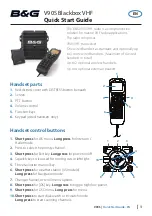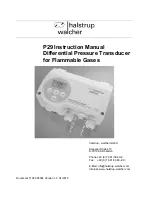
single MOSFET (see previous section). The two secondaries are connected as a center-
tapped single winding, which means that the outputs have 180-degree phase difference as
required.
The secondary “center-tap” is connected to a DC bias formed by R1, R2 and C6 at mid-rail
i.e. 2.5V. This simple bias does not source or sink any significant current due to the
balanced nature of the system, therefore no buffering is required. The DC bias feeds
through the pre-amps, and into later stages – including the 90-degree phase shift network
and the first three op-amps of the CW filter. It is a great benefit not to have to AC couple
each stage with coupling capacitors, and then bias each stage individually. In this circuit,
the same DC bias flows through all the way from this center-tapped input transformer. This
reduces component count and - you guessed it – complexity and cost. Another benefit is
that since much of the receiver signal path is DC coupled, it might be easier to reduce the
inevitable “thumps” on switching between receive and transmit.
Finally, the band pass filter is implemented by a fourth winding on the same transformer T1,
with some fixed capacitors and a trimmer capacitor forming the resonant circuit. It is only a
single resonant circuit band pass filter so has limited stop-band attenuation, but it does
have the benefit of low parts count, and simplicity of adjustment due to the single
adjustment control.
Note that the I and Q outputs each have a 0-ohm resistor (R246 and R245 respectively);
removal of these resistors disconnects the I & Q signals from the rest of the audio
processing; separate I & Q pads allow the signal to be routed to the uSDX daughtercard if
required.
4.6
90-degree audio phase shift
By this stage the I and Q outputs are each double-sideband, and we need to process them
to demodulate single sideband.
The circuit used here is an active two-path all-pass phase shift network based on four
operational amplifiers. The circuit is based on the same phase shift block as the Norcal
NC2030
http://www.norcalqrp.org/nc2030.htm
In the real world, nothing is perfect – there are component tolerances to think about. The
unwanted sideband suppression is maximized when the amplitude of the two paths is
equal, and the 90-degree phase shift is accurate.
QCX-mini assembly Rev 1.05_Fr
101
Summary of Contents for QCX-mini
Page 14: ...QCX mini assembly Rev 1 05_Fr 14...
Page 16: ...QCX mini assembly Rev 1 05_Fr 16...
Page 17: ...QCX mini assembly Rev 1 05_Fr 17...
Page 18: ...QCX mini assembly Rev 1 05_Fr 18...
Page 20: ...Main board Display board Controls board QCX mini assembly Rev 1 05_Fr 20...
Page 26: ...QCX mini assembly Rev 1 05_Fr 26...
Page 30: ...QCX mini assembly Rev 1 05_Fr 30...
Page 40: ...QCX mini assembly Rev 1 05_Fr 40...
Page 44: ...QCX mini assembly Rev 1 05_Fr 44...
Page 49: ...QCX mini assembly Rev 1 05_Fr 49...
Page 59: ...QCX mini assembly Rev 1 05_Fr 59...
Page 77: ...QCX mini assembly Rev 1 05_Fr 77...
















































